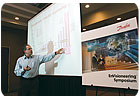
One of the “big ideas” proposed was the concept of building performance metrics. That is, every commercial building should meet certain energy-efficiency standards. If tied to federal or state legislation (or both), such standards would give building owners the incentive to implement improvements, resulting in higher energy efficiency across the building market. Those who don’t meet the standards would face the equivalent of a gas-guzzler tax, the group suggested.
“Without question, there is a growing need for a solid assessment of the economic payback of energy efficiency,” said John Galyen, host of the symposium and president, Danfoss Refrigeration & Air-Conditioning, North America. “One of the key questions the HVACR industry needs to ask is: Can total life-cycle costing help to significantly change buying practices in energy-efficiency solutions?”
Other meeting highlights included:
This was the fifth in a series of conferences sponsored by Danfoss, which is involved in research, development and production of mechanical and electronic components for applications in refrigeration and air conditioning, heating and motion control. The sixth symposium is scheduled for October 23, 2007, in Washington, DC.
For more information, call: GSI (202) 339-6207 or visit www.envisioneering.danfoss.com/symposium.


